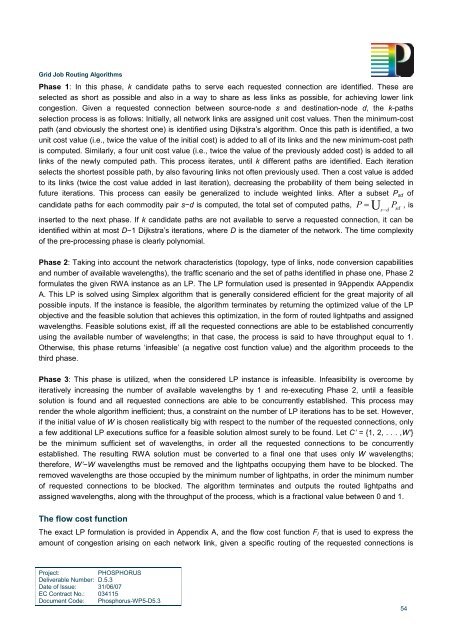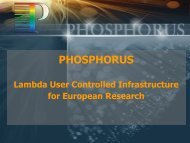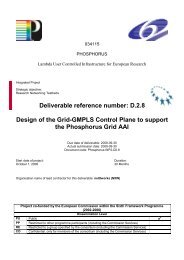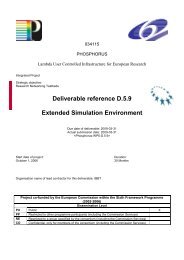Grid Job Routing Algorithms - Phosphorus
Grid Job Routing Algorithms - Phosphorus
Grid Job Routing Algorithms - Phosphorus
You also want an ePaper? Increase the reach of your titles
YUMPU automatically turns print PDFs into web optimized ePapers that Google loves.
<strong>Grid</strong> <strong>Job</strong> <strong>Routing</strong> <strong>Algorithms</strong>Phase 1: In this phase, k candidate paths to serve each requested connection are identified. These areselected as short as possible and also in a way to share as less links as possible, for achieving lower linkcongestion. Given a requested connection between source-node s and destination-node d, the k-pathsselection process is as follows: Initially, all network links are assigned unit cost values. Then the minimum-costpath (and obviously the shortest one) is identified using Dijkstra’s algorithm. Once this path is identified, a twounit cost value (i.e., twice the value of the initial cost) is added to all of its links and the new minimum-cost pathis computed. Similarly, a four unit cost value (i.e., twice the value of the previously added cost) is added to alllinks of the newly computed path. This process iterates, until k different paths are identified. Each iterationselects the shortest possible path, by also favouring links not often previously used. Then a cost value is addedto its links (twice the cost value added in last iteration), decreasing the probability of them being selected infuture iterations. This process can easily be generalized to include weighted links. After a subset P sd ofcandidate paths for each commodity pair s−d is computed, the total set of computed paths,P = U P , isinserted to the next phase. If k candidate paths are not available to serve a requested connection, it can beidentified within at most D−1 Dijkstra’s iterations, where D is the diameter of the network. The time complexityof the pre-processing phase is clearly polynomial.s−dsdPhase 2: Taking into account the network characteristics (topology, type of links, node conversion capabilitiesand number of available wavelengths), the traffic scenario and the set of paths identified in phase one, Phase 2formulates the given RWA instance as an LP. The LP formulation used is presented in 9Appendix AAppendixA. This LP is solved using Simplex algorithm that is generally considered efficient for the great majority of allpossible inputs. If the instance is feasible, the algorithm terminates by returning the optimized value of the LPobjective and the feasible solution that achieves this optimization, in the form of routed lightpaths and assignedwavelengths. Feasible solutions exist, iff all the requested connections are able to be established concurrentlyusing the available number of wavelengths; in that case, the process is said to have throughput equal to 1.Otherwise, this phase returns ‘infeasible’ (a negative cost function value) and the algorithm proceeds to thethird phase.Phase 3: This phase is utilized, when the considered LP instance is infeasible. Infeasibility is overcome byiteratively increasing the number of available wavelengths by 1 and re-executing Phase 2, until a feasiblesolution is found and all requested connections are able to be concurrently established. This process mayrender the whole algorithm inefficient; thus, a constraint on the number of LP iterations has to be set. However,if the initial value of W is chosen realistically big with respect to the number of the requested connections, onlya few additional LP executions suffice for a feasible solution almost surely to be found. Let C’ = {1, 2, . . . ,W’}be the minimum sufficient set of wavelengths, in order all the requested connections to be concurrentlyestablished. The resulting RWA solution must be converted to a final one that uses only W wavelengths;therefore, W’−W wavelengths must be removed and the lightpaths occupying them have to be blocked. Theremoved wavelengths are those occupied by the minimum number of lightpaths, in order the minimum numberof requested connections to be blocked. The algorithm terminates and outputs the routed lightpaths andassigned wavelengths, along with the throughput of the process, which is a fractional value between 0 and 1.The flow cost functionThe exact LP formulation is provided in Appendix A, and the flow cost function F l that is used to express theamount of congestion arising on each network link, given a specific routing of the requested connections isProject:PHOSPHORUSDeliverable Number: D.5.3Date of Issue: 31/06/07EC Contract No.: 034115Document Code: <strong>Phosphorus</strong>-WP5-D5.354






